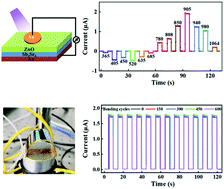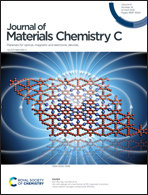A tailorable polarity-flipping response in self-powered, flexible Sb2Se3/ZnO bilayer photodetectors†
Abstract
The new era of the Internet of Things has spawned research into multifunctional photodetectors. Herein, the intriguing features of dual-polarity and flexibility are creatively embraced in Sb2Se3/ZnO bilayer photodetectors. The current reversal, with respect to the incident wavelengths, originates from the synergy of photovoltaic and photo-thermoelectric effects. An unprecedented polarity-double-flipping phenomenon was discovered at a critical thickness of the ZnO capping layer. The dual-polarity response is tailorable, as it is critically dependent on the band alignment, light penetration depth, and interfacial properties of the heterostructure. The optimal device has superior overall performance in terms of the response bandwidth, responsivity, detectivity, and response speed. The flexible devices can withstand 600 bending cycles with only a 4.38% degradation in the performance and a well-localized polarity-flipping wavelength. This study shows that the Sb2Se3/ZnO photodetector has excellent potential for use in bipolar signal communications in wireless, filterless, and wearable optoelectronic systems. It also paves the way for the design and optimization of flexible dual-polarity photodetectors from arbitrary hetero-assemblies.



 Please wait while we load your content...
Please wait while we load your content...